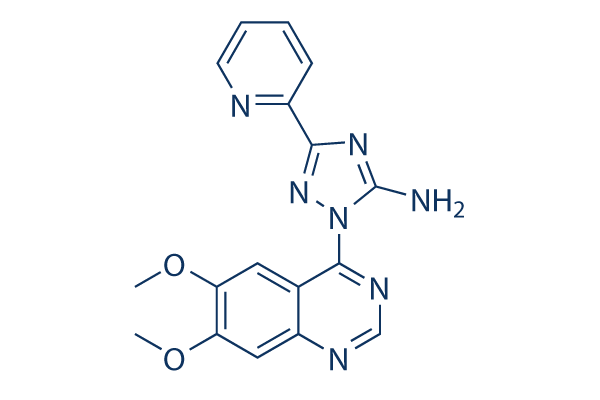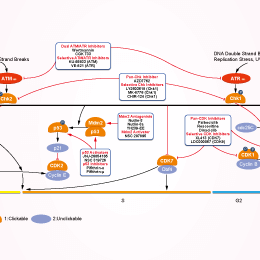
- Bioactive Compounds
- By Signaling Pathways
- PI3K/Akt/mTOR
- Epigenetics
- Methylation
- Immunology & Inflammation
- Protein Tyrosine Kinase
- Angiogenesis
- Apoptosis
- Autophagy
- ER stress & UPR
- JAK/STAT
- MAPK
- Cytoskeletal Signaling
- Cell Cycle
- TGF-beta/Smad
- DNA Damage/DNA Repair
- Compound Libraries
- Popular Compound Libraries
- Customize Library
- Clinical and FDA-approved Related
- Bioactive Compound Libraries
- Inhibitor Related
- Natural Product Related
- Metabolism Related
- Cell Death Related
- By Signaling Pathway
- By Disease
- Anti-infection and Antiviral Related
- Neuronal and Immunology Related
- Fragment and Covalent Related
- FDA-approved Drug Library
- FDA-approved & Passed Phase I Drug Library
- Preclinical/Clinical Compound Library
- Bioactive Compound Library-I
- Bioactive Compound Library-Ⅱ
- Kinase Inhibitor Library
- Express-Pick Library
- Natural Product Library
- Human Endogenous Metabolite Compound Library
- Alkaloid Compound LibraryNew
- Angiogenesis Related compound Library
- Anti-Aging Compound Library
- Anti-alzheimer Disease Compound Library
- Antibiotics compound Library
- Anti-cancer Compound Library
- Anti-cancer Compound Library-Ⅱ
- Anti-cancer Metabolism Compound Library
- Anti-Cardiovascular Disease Compound Library
- Anti-diabetic Compound Library
- Anti-infection Compound Library
- Antioxidant Compound Library
- Anti-parasitic Compound Library
- Antiviral Compound Library
- Apoptosis Compound Library
- Autophagy Compound Library
- Calcium Channel Blocker LibraryNew
- Cambridge Cancer Compound Library
- Carbohydrate Metabolism Compound LibraryNew
- Cell Cycle compound library
- CNS-Penetrant Compound Library
- Covalent Inhibitor Library
- Cytokine Inhibitor LibraryNew
- Cytoskeletal Signaling Pathway Compound Library
- DNA Damage/DNA Repair compound Library
- Drug-like Compound Library
- Endoplasmic Reticulum Stress Compound Library
- Epigenetics Compound Library
- Exosome Secretion Related Compound LibraryNew
- FDA-approved Anticancer Drug LibraryNew
- Ferroptosis Compound Library
- Flavonoid Compound Library
- Fragment Library
- Glutamine Metabolism Compound Library
- Glycolysis Compound Library
- GPCR Compound Library
- Gut Microbial Metabolite Library
- HIF-1 Signaling Pathway Compound Library
- Highly Selective Inhibitor Library
- Histone modification compound library
- HTS Library for Drug Discovery
- Human Hormone Related Compound LibraryNew
- Human Transcription Factor Compound LibraryNew
- Immunology/Inflammation Compound Library
- Inhibitor Library
- Ion Channel Ligand Library
- JAK/STAT compound library
- Lipid Metabolism Compound LibraryNew
- Macrocyclic Compound Library
- MAPK Inhibitor Library
- Medicine Food Homology Compound Library
- Metabolism Compound Library
- Methylation Compound Library
- Mouse Metabolite Compound LibraryNew
- Natural Organic Compound Library
- Neuronal Signaling Compound Library
- NF-κB Signaling Compound Library
- Nucleoside Analogue Library
- Obesity Compound Library
- Oxidative Stress Compound LibraryNew
- Plant Extract Library
- Phenotypic Screening Library
- PI3K/Akt Inhibitor Library
- Protease Inhibitor Library
- Protein-protein Interaction Inhibitor Library
- Pyroptosis Compound Library
- Small Molecule Immuno-Oncology Compound Library
- Mitochondria-Targeted Compound LibraryNew
- Stem Cell Differentiation Compound LibraryNew
- Stem Cell Signaling Compound Library
- Natural Phenol Compound LibraryNew
- Natural Terpenoid Compound LibraryNew
- TGF-beta/Smad compound library
- Traditional Chinese Medicine Library
- Tyrosine Kinase Inhibitor Library
- Ubiquitination Compound Library
-
Cherry Picking
You can personalize your library with chemicals from within Selleck's inventory. Build the right library for your research endeavors by choosing from compounds in all of our available libraries.
Please contact us at [email protected] to customize your library.
You could select:
- Antibodies
- Bioreagents
- qPCR
- 2x SYBR Green qPCR Master Mix
- 2x SYBR Green qPCR Master Mix(Low ROX)
- 2x SYBR Green qPCR Master Mix(High ROX)
- Protein Assay
- Protein A/G Magnetic Beads for IP
- Anti-Flag magnetic beads
- Anti-Flag Affinity Gel
- Anti-Myc magnetic beads
- Anti-HA magnetic beads
- Magnetic Separator
- Poly DYKDDDDK Tag Peptide lyophilized powder
- Protease Inhibitor Cocktail
- Protease Inhibitor Cocktail (EDTA-Free, 100X in DMSO)
- Phosphatase Inhibitor Cocktail (2 Tubes, 100X)
- Cell Biology
- Cell Counting Kit-8 (CCK-8)
- Animal Experiment
- Mouse Direct PCR Kit (For Genotyping)
- New Products
- Contact Us
CP-466722
CP-466722 is a potent and reversible ATM inhibitor, does not affect ATR and inhibits PI3K or PIKK family members in cells.

CP-466722 Chemical Structure
CAS No. 1080622-86-1
Purity & Quality Control
Batch:
S224501
4-Methylpyridine]5 mg/mL]true]DMSO]0.28 mg/mL]false]Water]Insoluble]false
Purity:
99.99%
99.99
CP-466722 Related Products
| Related Targets | ATM ATR | Click to Expand |
|---|---|---|
| Related Products | KU-55933 VE-821 KU-60019 Berzosertib (VE-822) Ceralasertib (AZD6738) AZ20 AZD0156 Mirin AZD1390 Elimusertib (BAY-1895344) hydrochloride ETP-46464 Elimusertib (BAY-1895344) CGK 733 VX-803 (M4344) AZ31 AZ32 HAMNO | Click to Expand |
| Related Compound Libraries | FDA-approved Drug Library Natural Product Library Apoptosis Compound Library DNA Damage/DNA Repair compound Library Cell Cycle compound library | Click to Expand |
Signaling Pathway
Biological Activity
| Description | CP-466722 is a potent and reversible ATM inhibitor, does not affect ATR and inhibits PI3K or PIKK family members in cells. | ||
|---|---|---|---|
| Targets |
|
| In vitro | ||||
| In vitro | In vitro, CP-466722 is identified as a potential inhibitor to decrease the activity of purified ATM kinase to phosphorylate GST-p53(1–101) substrate. In addition, CP-466722 also shows the inhibitory activities against abl and src kinases. [1] In HeLa cells, CP-466722 at doses of 6μM, results in the inhibition in ATM-dependent phosphorylation by reversibly inhibiting ionizing radiation (IR)-induced ATM kinase activity. Besides, ATM-dependent p53 induction is also inhibited by CP-466722 in MCF-7 human breast cancer cells and primary and immortalized diploid human fibroblasts. [1] In response to IR, CP-466722 increased proportion of cells with G2/M DNA content and reduces proportion of cells with G1-phase DNA content in HeLa cells. [1] Transient exposure to CP-466722 for a period of 4 hours sensitizes HeLa cells to IR without affecting cell plating nor cell viability. [1] | |||
|---|---|---|---|---|
| Kinase Assay | In vitro kinase assays [1] | |||
| To screen for small molecule inhibitors of ATM kinase activity, an in vitro kinase assay is adapted, and an ELISA assay develops which measured the phosphorylation status of the ATM downstream target p53. Recombinant GST-p53(1-101) and full-length Flag-tagged ATM & ATR are purified for use in the ELISA and in vitro kinase assays. Briefly, Nunc 96 well Maxisorp plates are coated overnight (4 °C) with 2μg of purified, recombinant GST-p53(1-101) in PBS. All subsequent incubations are performed at room temperature. The plates are washed (0.05%v/v-Tween/PBS) before addition of purified recombinant full-length ATM kinase (30 ng–60 ng) in a final volume of 80μL of reaction buffer (20 mM HEPES, 50 mM NaCl, 10 mM MgCl2, 10 mM MnCl2, 1 mM DTT and 1 μM ATP) in the presence or absence of CP-466722. CP-466722 (10μM) is added to plates in duplicate and the kinase assay is incubated (90 minutes). Plates are washed (0.05%v/v-Tween/PBS), blocked (1hour, 1%w/v-BSA/PBS) and rinsed before anti-Phospho(Ser15)-p53 antibody (1:1000/PBS) is added to the plates and incubated (1hour). To reduce non-specific binding plates are washed (0.05%v/v-Tween/PBS) prior to incubation (1hour) with HRP-conjugated goat anti-rabbit IgG secondary antibody (1:5000/PBS). Secondary antibody that is linked to the phosphorylated GST-p53(1–101) protein is detected with TMB substrate reagent. Plates are developed (15 minutes–30 minutes) and the reaction is stopped (1 M H2SO4 final concentration) before absorbance is determined (λ450nm). CP-466722 that inhibits ATM kinase activity in ELISA assays, are characterized with respect to inhibition of ATM/ATR kinases using in vitro kinase assays. Western blotting using the anti-Phospho(Ser15)-p53 antibody is used as a readout of ATM/ATR inhibition. Extended analysis of CP466722 (10 μM) against a commercially available panel of kinases is performed by Upstate. | ||||
| Cell Research | Cell lines | HeLa and A-T | ||
| Concentrations | 0-6 μM | |||
| Incubation Time | 4 hours | |||
| Method | HeLa or A-T (GM02052 expressing hTERT) cells are plated in triplicate and incubated for 24 hours. Cells are pre-treated: DMSO, CP466722 or KU55933 prior to IR (0-10Gy). Cells are incubated for 4 hours following IR before media is removed, cells washed (PBS), trypsined, counted and re-plated (2000 cells/plate, 10 cm plates) in the absence of drug and incubated for 10 days. Prior to colony counting, cells are washed (PBS), stained (PBS, 0.0037%v/v-formaldehyde, 0.1%w/v-crystal violet), rinsed (dH2O) and dried. Defined populations (>50 cells) are counted as one surviving colony, data are calculated as percentage surviving colonies relative to control plates +/− SE. |
|||
Chemical Information & Solubility
| Molecular Weight | 349.35 | Formula | C17H15N7O2 |
| CAS No. | 1080622-86-1 | SDF | Download CP-466722 SDF |
| Smiles | COC1=C(C=C2C(=C1)C(=NC=N2)N3C(=NC(=N3)C4=CC=CC=N4)N)OC | ||
| Storage (From the date of receipt) | |||
|
In vitro |
4-Methylpyridine : 5 mg/mL DMSO : 0.28 mg/mL ( (0.8 mM) Moisture-absorbing DMSO reduces solubility. Please use fresh DMSO.) Water : Insoluble |
Molecular Weight Calculator |
|
In vivo Add solvents to the product individually and in order. |
In vivo Formulation Calculator |
||||
Preparing Stock Solutions
Molarity Calculator
In vivo Formulation Calculator (Clear solution)
Step 1: Enter information below (Recommended: An additional animal making an allowance for loss during the experiment)
mg/kg
g
μL
Step 2: Enter the in vivo formulation (This is only the calculator, not formulation. Please contact us first if there is no in vivo formulation at the solubility Section.)
% DMSO
%
% Tween 80
% ddH2O
%DMSO
%
Calculation results:
Working concentration: mg/ml;
Method for preparing DMSO master liquid: mg drug pre-dissolved in μL DMSO ( Master liquid concentration mg/mL, Please contact us first if the concentration exceeds the DMSO solubility of the batch of drug. )
Method for preparing in vivo formulation: Take μL DMSO master liquid, next addμL PEG300, mix and clarify, next addμL Tween 80, mix and clarify, next add μL ddH2O, mix and clarify.
Method for preparing in vivo formulation: Take μL DMSO master liquid, next add μL Corn oil, mix and clarify.
Note: 1. Please make sure the liquid is clear before adding the next solvent.
2. Be sure to add the solvent(s) in order. You must ensure that the solution obtained, in the previous addition, is a clear solution before proceeding to add the next solvent. Physical methods such
as vortex, ultrasound or hot water bath can be used to aid dissolving.
Tech Support
Answers to questions you may have can be found in the inhibitor handling instructions. Topics include how to prepare stock solutions, how to store inhibitors, and issues that need special attention for cell-based assays and animal experiments.
Tel: +1-832-582-8158 Ext:3
If you have any other enquiries, please leave a message.
* Indicates a Required Field
Tags: buy CP-466722 | CP-466722 supplier | purchase CP-466722 | CP-466722 cost | CP-466722 manufacturer | order CP-466722 | CP-466722 distributor







































